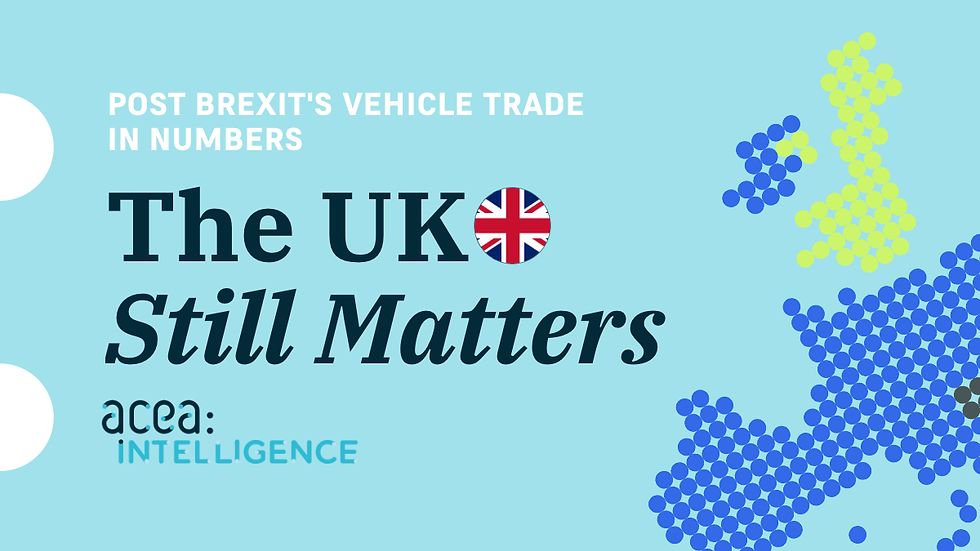The UK Still Matters: Post-Brexit Vehicle Trade in Numbers
- Alexandre PROVOST
- Oct 21
- 3 min read

Copyright (c) ACEA:intelligence 2025
Five years after Brexit, Europe and the UK remain part of the same automotive ecosystem.
A relationship that endured the shock
When the United Kingdom officially left the European Union in January 2020, most forecasts were gloomy. Analysts expected a sharp contraction in cross-Channel trade, disrupted supply chains, and a long period of reorganisation for the automotive industry.
Five years later, the picture looks strikingly different. According to ACEA:intelligence's Vehicle Trade Flows per Partner database, over 1.6 million vehicles were exported from the EU to the UK in 2024 — representing roughly 22% of all EU vehicle exports, placing the UK as Europe’s number one export destination for passenger cars.
At the same time, imports from the UK to the EU exceeded 400,000 units — less than before Brexit, but still a substantial figure showing that industrial interdependence did not vanish with political separation.
In other words, the car trade bridge across the Channel has narrowed, but it has not collapsed.
A trade built on shared industrial roots
This resilience has deep structural reasons. The European and British automotive sectors have long operated as a single production network, with components, finished vehicles, and technologies moving seamlessly between plants located in the UK, Germany, France, Spain, Belgium, and beyond.
Even after Brexit, these production ecosystems remain tightly interwoven. For instance, engines built in the UK still equip vehicles assembled in continental Europe, while vehicles produced in mainland factories — particularly premium and electric models — continue to feed the British market.
Moreover, several major OEMs maintain dual footprints across the two sides of the Channel, optimising logistics, tax rules, and market access through specialised production. That legacy makes a full decoupling both economically irrational and technically complex.
From disruption to adaptation
The years 2020–2021 were undoubtedly turbulent. New customs procedures, rules of origin, and paperwork costs initially slowed down trade flows. Many companies faced delays and re-evaluated their logistics chains.
But by 2022, the data shows a clear rebound and stabilisation. Customs operations have matured, digital systems are now more interoperable, and logistics partners have adapted.
The conclusion is clear: companies learned to live with Brexit. Instead of reversing decades of integration, the automotive industry absorbed the shock and reconfigured itself to continue functioning — efficiently, if not as effortlessly as before.
The rise of electrified trade
Beyond the trade mechanics lies another transformation: electrification. The UK is one of Europe’s most dynamic markets for electric and hybrid vehicles, and that demand is directly reflected in trade data.
Between 2019 and 2024, the share of electrified vehicles in EU exports to the UK more than doubled. This trend is partly driven by regulatory alignment: despite Brexit, the UK has maintained many EU-derived environmental targets, ensuring continuity in product homologation and emissions standards.
It also reflects industrial complementarity:
the EU is the largest producer of electric vehicles in Europe,
the UK remains a major importer and technology partner for electrification components, from batteries to charging systems.
As the green transition accelerates, this interdependence will likely deepen rather than fade.
Data speaks louder than politics
Political narratives often suggest separation. Data, on the other hand, reveals interconnection.
Trade in vehicles and components between the EU and the UK remains a powerful reminder that economic geography does not change overnight. Decades of investment, supplier networks, and human expertise have created a fabric that no border can easily cut through.
“Reliable data helps cut through political noise. The EU and the UK are still, in many ways, part of the same automotive ecosystem.”
The view from the data
ACEA:intelligence's Vehicle Trade Flows per Partner dataset — covering the period 2019–2024 — provides a comprehensive picture of these dynamics, with harmonised customs data.
The database allows users to:
track monthly and yearly trade flows by partner country,
distinguish exports and imports by vehicle type,
analyse post-Brexit trends through interactive dashboards.
Preliminary trade data for January–July 2025 are already available and confirm the overall stability of EU–UK vehicle flows, consolidating 2024’s trend of resilient bilateral exchange.
Discover more insights and dashboards at 👉 www.aceaintelligence.eu
About ACEA:intelligence
ACEA:intelligence is the intelligence hub of the European Automobile Manufacturers' Association (ACEA). It provides trusted, first-hand automotive data — from production and registrations to electrification, employment, and trade — helping decision-makers, researchers, and businesses navigate Europe’s evolving mobility landscape.
